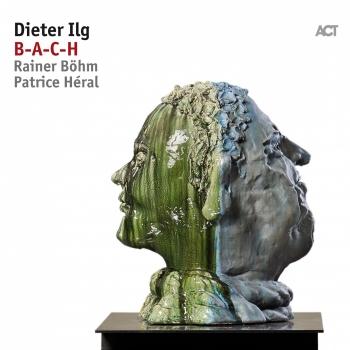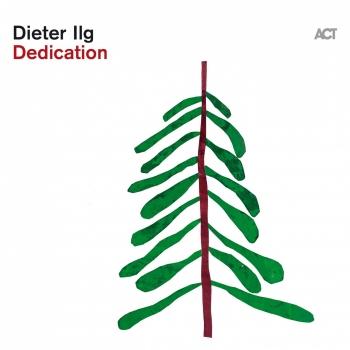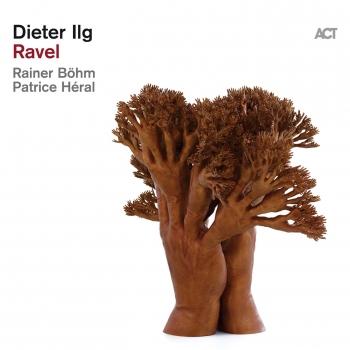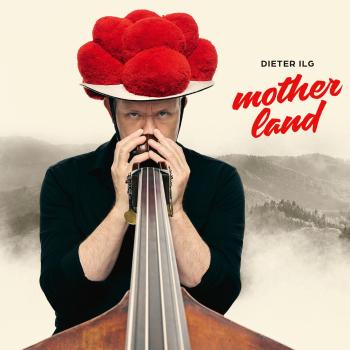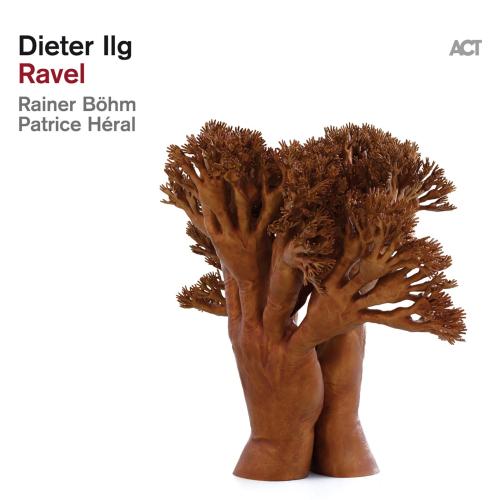
Ravel Dieter Ilg
Album info
Album-Release:
2022
HRA-Release:
30.09.2022
Album including Album cover Booklet (PDF)
- 1 Menuet Sur Le Nom De Haydn 04:14
- 2 Quatuor 04:22
- 3 Trio 06:56
- 4 Pavane Pour Une Infante Défunte 06:13
- 5 Alborada del Gracioso 03:53
- 6 Bolero 04:21
- 7 Valse II 05:52
- 8 Adagio Assai 06:10
- 9 Sonatine I 04:42
- 10 Pavane De La Belle Au Bois Dormant 04:53
- 11 Le Jardin Féerique 05:59
- 12 Sonatine II 05:39
- 13 Valse VI 02:47
Info for Ravel
Verdi, Wagner, Beethoven, Bach...Germany’s premer jazz bassist Dieter Ilg has instigated several creative projects, in which he has taken the great composers of Western classical music off in new directions. Here, alongside pianist Rainer Böhm and drummer Patrice Héral, his focus turns to Ravel.
It was the 1899 piano piece "Pavane pour une infante défunte" (pavane for a dead Infanta) which first spurred Ilg’s interest in the French ‘maître’. Ilg had been fascinated many years ago by the version with Jim Hall and Art Farmer: "When I was looking for a new source of inspiration for my trio, the memory of this piece came back to me. We delved deeper into Ravel's oeuvre and found a wide range of interpretative approaches that are not to be encountered in Beethoven or Bach. His music is tailor-made for us!"
Perhaps it is not surprising that Ilg should be drawn to Maurice Ravel, given that the bassist’s artistic approach is in its essence impressionistic. Claude Monet once said about his paintings: "I'm interested in what happens between me and the object.” This is equally true for Ilg's creative process, because the musical templates act as the trigger for his own feelings, which he then processes into new sounds: "I don't work according to any plan, I don't want to just reproduce anything, but rather to create something of my own which keeps the masters in mind.” Ilg’s only requirement is that pieces should "jump out at him", as he describes it. The precise means by which that initial impulse happens is always left open: it might be a melody, a rhythmic figure, a chord progression or even a mood that creates the attraction. "Listen and decide in the moment" is Ilg's motto for the process of composing, and even more so when it comes to the improvisations with the trio, when the act of creation takes place in real-time.
In "Ravel", the observer becomes the subject: "Ravel leaves us latitude and uncertainty as to what is right or wrong”, says Ilg. “Freedom of interpretation is already inherent in his music, so it can be transformed into jazz quite organically." Maybe this is also the case because Ravel's work coincided with the genesis of jazz, and because he had such open ears for it. With George Gershwin, he travelled around Harlem in the 1920s to hear Duke Ellington and others. In addition, Paris, where Ravel lived, was in thrall to music from America such as ragtime and then jazz. All of this left a profound mark on Ravel's music. The musical current known as impressionism opened the doors for the contemporary music of the 20th century. It is therefore an ideal terrain to nurture Ilg's own jazz approach to the art of variation.
A cornucopia of different musical moods awaits the listener. The atmospheric "Pavane Pour Une Infante Défunte" is followed by the agitated, rhythmically moving "Alborada Del Gracioso". The "Trio" leads into a firework display of improvisation and "Valse II" swings with gracious ease. The album ends dreamily with "Le Jardin Féerique". It would have been impossible to leave out "Bolero" with its concise rhythmic ‘idée fixe’. It was drummer Patrice Héral, unsurprisingly, who proposed it. And whereas Ravel once said ironically about his masterpiece: “It's just a pity that it contains no music at all," this is simply not true of Ilg's version, where the melodic material of the theme takes some surprising turns at the instigation of pianist Rainer Böhm.
In "Ravel" we find interaction, excitement, joyous participation. At every moment Ilg, Böhm and Héral take equal roles in shaping the music. Freedom of expression is supreme. Solos are never a matter of egotistical display, what matters is how they can provide impulses for the group a as a whole: “It has been a long time since a trio seemed as intensely enmeshed with each other as this one," as a writer from NDR expressed it. Their musicianship opens up a highly individual musical world that makes one marvel at the naturalness, sensitivity and empathy with which bridges are built between classical music and jazz.
What is original, what is variation here? Where does Ravel end and Ilg begin...? Maybe one does not need to understand great art. As Monet himself proposed: "It's simply necessary to love."
Dieter Ilg, bass
Rainer Böhm, piano
Patrice Héral, drums
Dieter Ilg
Bassist Dieter Ilg is regarded today as one of a handful of European musicians who make their unmistakable musical style a valuable contribution to the projects they work on.
Whether it is as a internationally well-respected sideman or as band leader of his own ensembles: Ilg always combines the quality of the bass as a musical foundation with a graceful ease and expression that is rarely heard on a technically difficult instrument such as the double bass.
It is sometimes assumed that there are two kinds of bass players: those who “groove” and accompany (serving mainly as a rhythmic presence) or those who – freeing themselves of the serving role – strive to explore their artistic heights as a soloist (displaying their versatility as virtuoso improvisers). Unlike many Dieter Ilg combines the two ends of this spectrum.
His versatile, individual, passionate and tasteful voice has become a valuable contribution to the international jazz arena.
At the age of six Dieter Ilg – then an experienced recorder player (in kindergarten) – learned to play the violin and the viola before deciding to play the double bass at the age of thirteen.
After four years of lessons at the music school in his home town Offenburg Ilg went on searching for new teachers. He studied with Norbert Brenner ( solo double bass player of the SWR Orchestra Baden-Baden) and later on attended Jazz courses in Burghausen, Remscheid and Tübingen, working with a wide variety of instructors and professionals.
From 1981 until 1985 Ilg refined his practical skills as well as his theoretical knowledge with Prof. Wolfgang Stert at the Musikhochschule Freiburg. Winning the Fulbright scholarship then enabled him to study at the Manhattan School of Music in New York City (1986/1987).
At this time he was already skilled enough to understand the art of musical structure as it was conveyed to him by such masters as Eddie Gomez, Ron McClure, Rufus Reid, Adelhard Roidinger and Miroslav Vitous. It was also then that he made his further experiences on the stage as a member of the Joe Viera Sextett (1981 – 1984) as well as with his first trio-project, co-founded with Klaus Ignatzek. Not before long he had built up a busy schedule performing with such players as Bobby Watson or David Liebman.
It was Liebman who significantly influenced Ilg’s decision to stay on in New York for a while when he invited him to join the John Coltrane Memorial Concert in NYC in January 1987. The future began to look exciting.
Seizing the moment Ilg founded his first Trio with guitarist John Schröder and drummer Wolfgang Haffner shortly after returning from New York. He also became a member of the Randy Brecker Quintet (1987-89). Suddenly things were on a roll and he was awarded with the Baden-Württemberg Jazz Prize in 1988. The press said:
The brilliance and expression of his tone, the originality in the concept of his ensemble and his individual approach to harmony are fascinating.
Regular performances with the WDR Big Band (recordings with Bob Brookmeyer, John Abercrombie, Danny Gottlieb, Charlie Mariano, Peter Erskine, Nguyen Le, Vince Mendoza and others), frequent tours in europe (for example a tour of Spain with Bennie Wallace ) and a new line up to his own trio – this time including pianist Marc Copland – is what followed. These collaborations resulted in the production of three CD’s featuring drummers Bill Stewart, Ralph Penland and Jeff Hirshfield. ...
Booklet for Ravel










